-
Getting Started
-
Garmin Devices
-
Setup
-
Manage
-
Data Collection
- Collect Data: Synchronization Types
- Collect Data: Tablet Sync (multi-sync) with "Fitrockr Hub (Multi-Sync)" app
- Collect Data: Smartphone Sync (single-sync) with Garmin Connect app
- Collect Data: Overview
- Collect Data: Smartphone Sync (single-sync) with Fitrockr app
- Collect Data: Sync via USB cable to Laptop
- Collect Data: Smartphone Sync (single-sync) with Omron Blood Pressure Monitors
-
Track
-
Analyze
-
Other
-
Trouble Shooting
-
Definitions
-
FAQ
How to read Accelerometer json output file
Collecting accelerometer data will generate a huge amount of data (25Hz = 25 measurements per second). It is recommended to export and assess accelerometer data as JSON file format.
The output file will include user information and all measured accelerometer values.
Measured values will be provided in arrays of 25 samples per second. This means that each sample represents a 1/25 fraction of a second.

t: Unix timestamp.
The unix time stamp is a way to track time as a running total of seconds. This count starts at the Unix Epoch on January 1st, 1970 at UTC. Therefore, the unix time stamp is merely the number of seconds between a particular date and the Unix Epoch.
See also Unix Time Stamp Converter
offset: defines the timezone. It represents the difference between user’s local time and Coordinated Universal Time (UTC). It is expressed in seconds. For instance, -14400 represents a timezone difference of -4hrs.
fraction: accelerometer is measured 25 times per second. The fraction represents the time of each measurement related to “t”. For instance, fraction “0” represents the first measurement at “t” (e.g. 6:00:00.000 AM) and fraction “0.04” represents 40 milliseconds (1000 milliseconds * 0.04) later which would be 6:00:00.040 AM.
x, y, z: represent acceleration values along three perpendicular axes in a 3D space. The unit of measurement for accelerometer is milli-G’s.